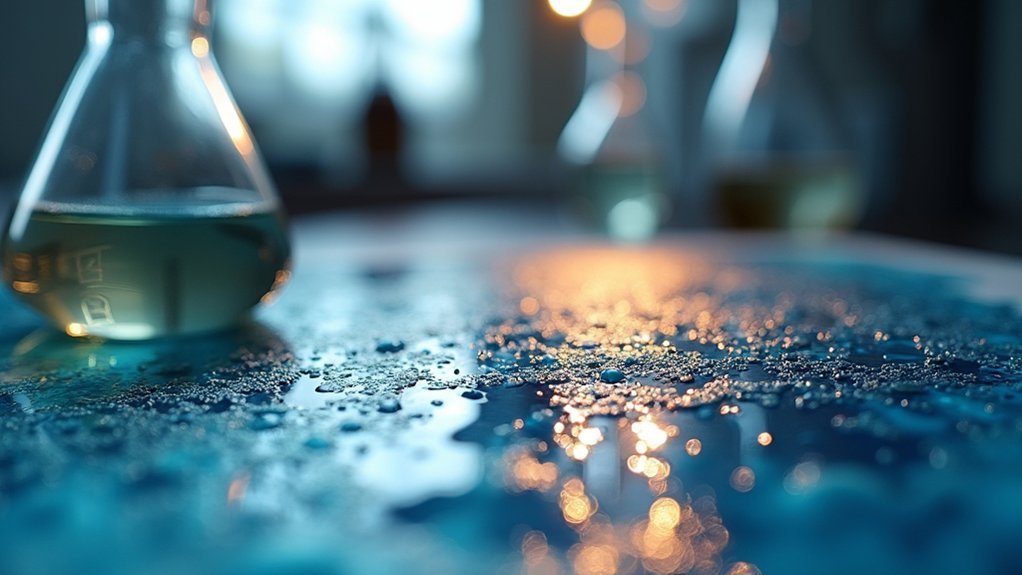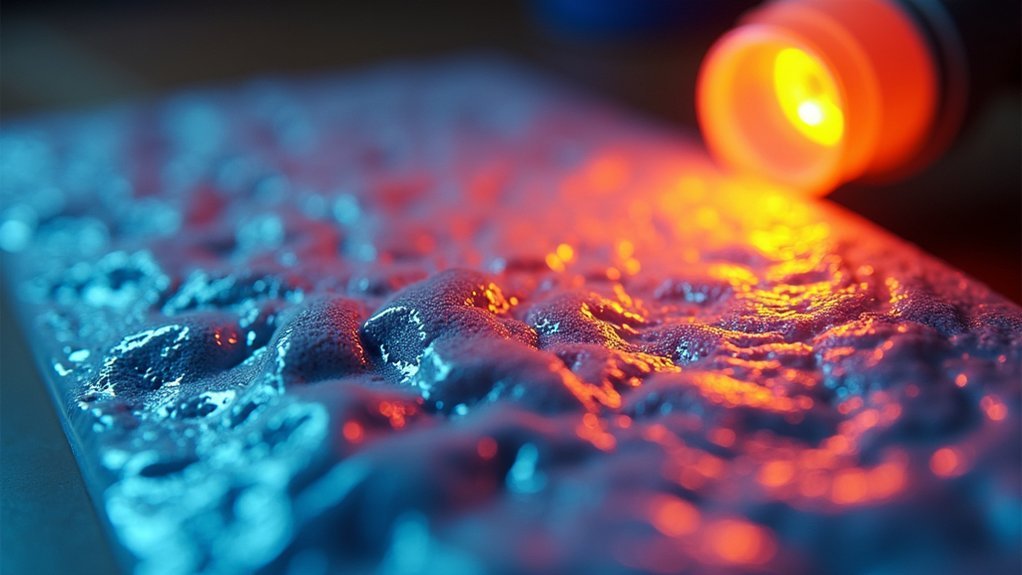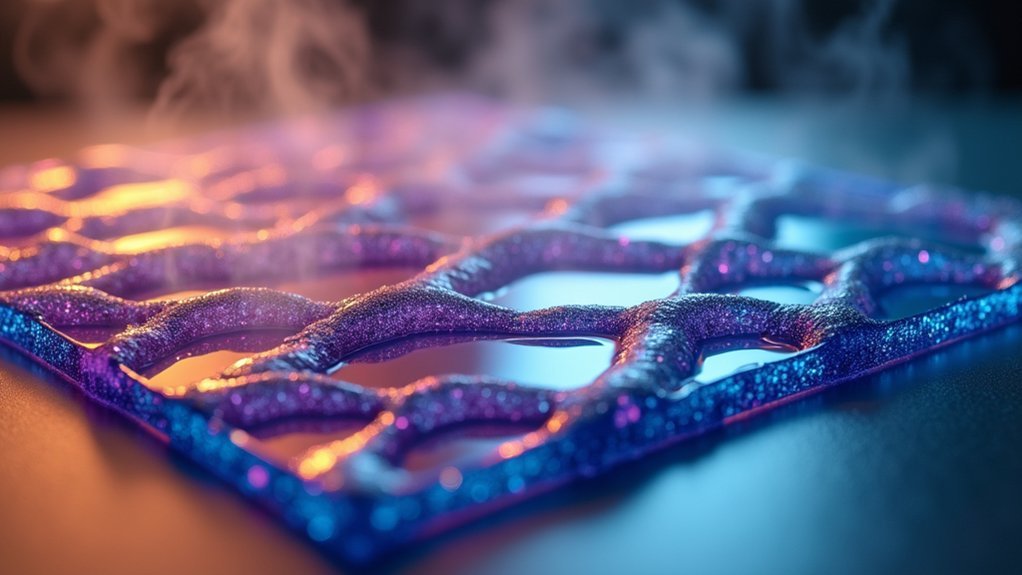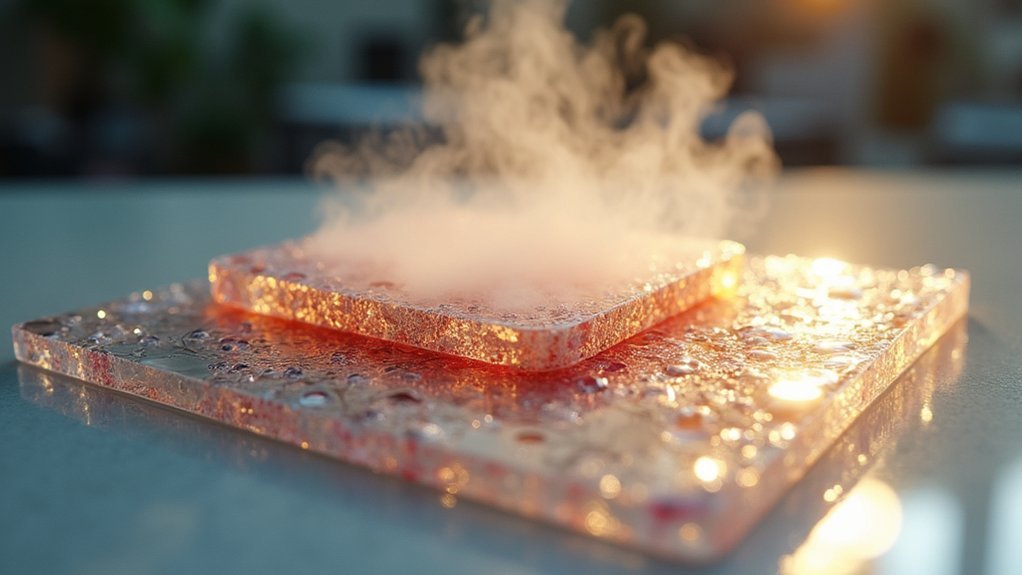Post-curing completes the polymerization process that UV printing leaves unfinished, transforming your prints from a weak “green state” to fully cross-linked polymers. Fresh SLA prints only cure about 0.1mm deep, leaving interior layers with incomplete polymer networks that create brittle failure points. Combined UV and heat treatment drives cross-linking throughout the entire part, boosting tensile strength by up to 41% and achieving peak strength of 68 MPa. Understanding ideal curing conditions will maximize your prints’ mechanical properties.
Understanding the Resin Curing Process and Polymer Chemistry

When you expose liquid resin to UV light during 3D printing, you’re triggering a photopolymerization reaction that transforms light-sensitive monomers into solid polymer chains. This resin curing process creates your printed part in what’s called the “green state” – partially polymerized but not fully cured.
During photopolymerization, some resin molecules remain uncured, leaving incomplete polymer networks that compromise your print’s structural integrity. That’s where post-curing becomes essential. This additional treatment completes the polymerization process, forming stronger cross-links between polymer chains.
The enhanced polymer network directly impacts your print’s mechanical properties, including strength, stiffness, and temperature resistance.
Post-curing transforms weak green-state prints into durable parts with superior strength, rigidity, and heat resistance through complete polymer cross-linking.
Without proper post-curing, you’ll have weaker parts with reduced performance capabilities, especially for functional applications requiring optimal material characteristics.
The Green State Problem in Fresh SLA Prints
Fresh SLA prints straight from your build platform carry a significant burden: they’re stuck in what manufacturers call the “green state.”
This intermediate condition means your parts contain substantial amounts of uncured resin trapped within the polymer matrix, creating a host of problems that directly impact performance.
The uncured resin creates weak points throughout your print’s structure, making it brittle and prone to failure under stress.
Your mechanical properties remain severely compromised until you address this issue. For medical applications, the green state poses additional biocompatibility risks that can’t be ignored.
Without proper post-curing, you’re fundamentally working with incomplete parts that haven’t reached their full potential for durability, strength, or thermal resistance.
How UV Light and Heat Transform Molecular Structure

When you expose your resin print to UV light during post-curing, the photons only penetrate about 0.1mm into the material, leaving deeper layers partially uncured.
You’ll need to add heat to the process because it drives cross-linking reactions throughout the entire part, transforming loose polymer chains into a dense, interconnected network.
This combined UV and thermal treatment fundamentally changes your print’s molecular structure, converting it from a weak “green state” into a fully polymerized material with dramatically improved strength properties.
UV Light Penetration
Although your resin printer’s LCD screen delivers intense UV light during the initial printing process, this light barely penetrates beyond 0.1mm into your print’s surface.
This shallow UV light penetration creates a fundamental limitation in achieving fully cured prints straight from the build plate. The interior remains largely uncured, compromising structural integrity.
Understanding this limitation explains why post-curing resin becomes essential for superior results:
- Surface Shell Effect – Your print develops a thin, cured outer shell while the interior stays liquid or semi-solid
- Incomplete Polymerization – Uncured resin pockets weaken the overall structure and reduce mechanical properties
- Layer Adhesion Issues – Insufficient curing between layers creates weak points prone to failure
The curing process requires additional UV exposure to penetrate deeper layers and achieve complete polymerization throughout your print’s entire structure.
Heat Cross-Linking Effects
Post-curing transforms your resin print’s molecular structure through a powerful combination of UV light and controlled heat that creates stronger cross-links between polymer chains.
While UV light initiates photopolymerization at the surface, heat penetrates deeper into your print, reaching areas beyond UV’s limited 0.1mm penetration depth. This thermal energy promotes additional bonding between polymer chains, considerably enhancing your part’s mechanical properties.
During extended curing time at temperatures like 65°C, you’ll achieve up to 41% greater tensile strength compared to ambient temperature curing.
Heat guarantees complete polymerization throughout your print’s thickness, eliminating brittleness from insufficient curing. The synergistic effect dramatically improves impact strength, creating more durable parts that resist cracking and failure under stress.
Mechanical Property Changes During Post-Curing
As your resin prints undergo post-curing, their molecular structure undergoes a dramatic transformation that fundamentally alters their mechanical properties.
The curing process drives complete polymerization, converting your prints from their vulnerable “green state” to fully cross-linked polymers with enhanced strength and temperature resistance.
Post-curing transforms vulnerable green-state prints into fully cross-linked polymers with dramatically enhanced strength and temperature resistance.
You’ll notice significant improvements across multiple mechanical properties:
- Tensile strength increases by an average of 41% when you cure at 80°C versus ambient temperatures
- Peak strength reaches up to 68 MPa in properly heat-cured samples compared to just 48 MPa in ambient-cured ones
- Surface finish transforms from glossy to matte, indicating complete polymerization has occurred
These changes aren’t just cosmetic—they’re fundamental shifts in your print’s ability to withstand stress, heat, and long-term use.
Temperature’s Role in Strengthening Polymer Cross-Links

When you apply heat during post-curing, you’re directly accelerating the formation of stronger polymer cross-links that determine your print’s final strength.
Temperature plays a critical role in this process, as higher temperatures up to 80°C greatly increase tensile strength by facilitating better molecular alignment and cross-linking throughout your resin.
Research demonstrates that samples cured at 65°C achieved 68 MPa average strength—41% stronger than ambient temperature curing.
You’ll find that effective curing requires combining UV light with elevated temperatures, since UV light alone can’t sufficiently penetrate deeper layers.
This thermal enhancement reduces brittleness while creating more robust, durable prints with superior mechanical properties compared to standard room-temperature processing methods.
Optimal Curing Duration for Different Resin Types
While temperature fine-tuning provides the foundation for stronger prints, timing your post-curing duration correctly guarantees you’re maximizing each resin’s unique properties.
Standard resins like White, Grey, Black, and Clear need just one minute of post-curing to achieve ideal mechanical properties. However, engineering resins demand considerably longer exposure—up to 120 minutes—to access their enhanced strength and rigidity potential.
Your ideal curing duration depends on several factors:
- Resin type complexity – Engineering materials require extended processing compared to standard formulations.
- Print geometry size – Large or intricate parts need longer exposure for uniform strength distribution.
- Environmental conditions – Temperature and humidity variations affect curing effectiveness.
You’ll find specific post-curing settings for each resin type on Formlabs’ material data sheets, ensuring you achieve the mechanical properties your application demands.
Why Surface Curing Alone Isn’t Enough for Strength
When you rely on surface curing alone, you’re only hardening the outer 0.1mm of your resin print while leaving the interior in a weak, uncured state.
UV light can’t penetrate deeper into the material, which means the bulk of your print remains in what’s called a “green state” with inadequate polymerization.
This incomplete internal curing creates a false sense of strength since the surface feels solid, but the core structure lacks the molecular bonds needed for true durability.
Limited UV Penetration Depth
Although your freshly printed resin parts may appear fully cured on the surface, UV light penetrates only about 0.1mm into clear resins during the printing process.
This limited uv penetration depth creates a deceptive scenario where your print feels solid but harbors significant structural weaknesses beneath.
The shallow curing creates three critical problems:
- Green state interior – The core remains soft and chemically unstable despite a firm outer shell
- Incomplete polymer chains – Molecular bonds can’t form properly without adequate UV exposure throughout the material
- Structural brittleness – Parts break unexpectedly under stress due to weak internal bonding
Without proper post-curing strategies, residual uncured resin compromises your print’s integrity.
Only extended heat and UV treatment can fully cure the entire cross-section, eliminating these hidden vulnerabilities.
Incomplete Internal Polymerization
Even if your resin print’s surface feels rock-solid, you’re dealing with a deceptive shell that masks serious internal weaknesses.
Since UV light only penetrates approximately 0.1mm into your print, the interior remains largely uncured while the surface hardens completely. This creates a troubling scenario where your part appears fully cured but contains pockets of liquid or semi-liquid resin trapped inside.
Without proper post-curing, this incomplete polymerization severely compromises your print’s mechanical properties.
The uncured interior acts like a structural fault line, making your part vulnerable to cracking, deformation, or complete failure under stress.
You’ll notice sticky areas or persistent glossy patches that refuse to cure, clear indicators that your print needs additional UV exposure to achieve full internal strength.
Measuring Tensile and Impact Strength Improvements
As thermal post-curing transforms resin prints at the molecular level, you can measure these improvements through standardized tensile and impact strength testing.
When you cure Siraya Tech’s Blu resin samples at 65°C, you’ll achieve 68 MPa tensile strength—that’s 41% stronger than ambient-cured samples at 48 MPa. Even moderate heating at 40°C boosts strength to 56 MPa, approaching maximum performance levels.
Your impact strength testing will reveal:
- Rugged fracture surfaces on thermally-cured samples indicating enhanced material integrity
- Slight reduction in impact resistance with thermal curing, though still superior to PLA and PETG
- Alternative annealing at 80°C after UV curing delivers nearly identical strength improvements
These measurable gains demonstrate how controlled thermal post-curing optimizes your resin print’s mechanical properties.
Over-Curing Risks and Material Degradation
While thermal post-curing delivers impressive strength gains, you must guard against over-curing, which triggers molecular degradation that undermines your print’s mechanical properties.
Excessive UV exposure causes brittleness and porosity, greatly reducing tensile strength compared to properly cured parts. You’ll face heightened risks with complex geometries, where uneven light distribution creates inconsistent material strength throughout your print.
Monitor your prints carefully during curing—sticky surfaces indicate under-curing, while glossy finishes suggest over-curing and material degradation.
Extended exposure beyond recommended settings destroys the crosslinked polymer structure you’ve worked to build. Regular process checks prevent this deterioration, ensuring you achieve ideal strength without sacrificing material integrity.
Balance remains key to maximizing your resin print’s mechanical performance.
Frequently Asked Questions
What Happens if You Overcure Resin?
When you overcure resin, you’ll create brittle prints with reduced mechanical strength and increased porosity. Your prints become more prone to fracture, lose elongation properties, and may develop structural weaknesses that compromise their integrity.
How Long Should You Post Cure Resin Prints?
You should post-cure standard resins for about one minute in a Form Cure, while engineering resins need up to 120 minutes. Consider your print’s geometry and specific resin requirements for ideal strength.
Why Is My Resin Print Tacky After Curing?
Your resin print’s tacky because you didn’t cure it long enough or clean off uncured resin properly beforehand. Extend your curing time, use stronger UV exposure, or try underwater curing methods.
Why Are My Resin Prints so Brittle?
Your resin prints are brittle because they’re incompletely polymerized. You need longer post-curing times with proper UV exposure and heat to fully transform the resin, eliminating weak uncured areas.





Leave a Reply